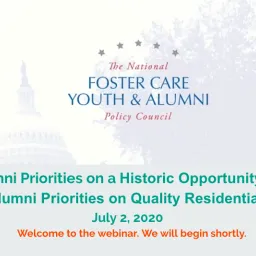On July 2, 2020, The National Foster Care Youth and Alumni Council hosted a webinar to discuss their 2020 Priorities: A Historic Opportunity to Reform the Child Welfare System: Youth & Alumni Priorities on Quality Residential Services Webinar. The webinar featured two Council Members, Ke’Onda Johnson, from Florida and David Hall, from Oklahoma. David and Ke’Onda provided first-hand information about best practices and policy recommendations for improving Quality Residential Treatment Placements (QRTPs).
You can watch the A Historic Opportunity to Reform the Child Welfare System: Youth & Alumni Priorities on Quality Residential Services Webinar here.
Here is a summary of their priorities:
Ensure QRTPs are taking care of the needs of the “tough” kids, and not just those with the easiest to meet needs.
“ The Council is concerned that programs will and are ‘cherry-picking’ kids to allow into their programs. We believe this may be an unintended consequence of programs working to develop an evidence based program, that demonstrates the effectiveness of their intervention, and have concerns that some youth, particularly those with multiple challenges are not and will not be included in any services and do not have programs made for them.”
Ensure my entry into a QRTP intervention is fair and appropriate.
“Arms-length, independent assessments should be used to ensure the young person is provided appropriate treatment in the least restrictive family-like environment. Assessment should provide young people the opportunity to meaningfully participate to the extent possible, and provide their own point of view regarding their mental health, behavioral health or specialized needs expressed in the referral to QRTP prepared by caregivers and professionals.”
If it is determined a QRTP intervention is the best option, it should be within the young person’s community. If it can’t be, it is incumbent on child welfare professionals to ensure the young person has access to and is able to retain their community, family, and cultural connections.
“My mom wasn’t able to visit me because the facility I was in was hours away from our community. She couldn’t afford to take the whole day off work, as visiting hours were limited to business hours.” - David
Part of curbing the over-reliance of medication is to ensure informed consent and have an established and independent appeal process available to youth with a medication.
“ Too often, medication is often offered as the ‘first fix’ when a young person exhibits issues due to trauma.” -Ke’Onda
Systems should have standards and measures of well-being, and QRT Ps should be held accountable to meet these standards in a young person’s treatment plan.
“ QRTPs should support and measure youth-directed, strength-based progressional outcomes for a young person’s well-being. These standards should include a measure of whether young people have the ability to do culturally, developmentally, and age appropriate activities.”
Urgently address the vulnerabilities to sex-trafficking that are associated with placement in a QRTP.
“ Ask any former or current foster youth about the first 3 things that come to mind when they hear QRTP and I guarantee sex trafficking will be number one or two followed by lack of necessities.Youth in care are at a greater risk of being trafficked due to lack of personal necessities i.e hygiene products, food they actually like eating, activities with friends etc. things youth who aren’t in qrtp’s do without a second thought or they just want to be loved and listened to.” - Ke’Onda
Council members discussed the impact that COVID-19 has had on QRTPs and the youth who are currently placed in them. They stated that youth should not be placed in a QRTP as a “quick fix” during a pandemic as it not only rash, but would consider it child neglect. It is virtually impossible to social distance in a QRTP and unlike a family setting QRTPs have shift workers who may be infected and could transmit the virus to youth. The webinar illustrated how imperative constituent engagement is at every level - from developing Quality Residential Services to choosing them as a placement for youth and engaging youth and family in the process.
Resources provided in the webinar:
2016 Improving Policies and Services in Congregate Care Settings
2016 Reducing Reliance on Congregate Care
ACYF-CB-IM-19-03
https://www.acf.hhs.gov/sites/default/files/cb/im1903.pdf
2020 Quality Residential Services
Defining QRTPs (Qualified Residential Treatment Programs)
Reducing Vulnerability of Foster Youth to Predators and Sex Trafficking Priority)
You can listen to the A Historic Opportunity to Reform the Child Welfare System: Youth & Alumni Priorities on Quality Residential Services Webinar here.

